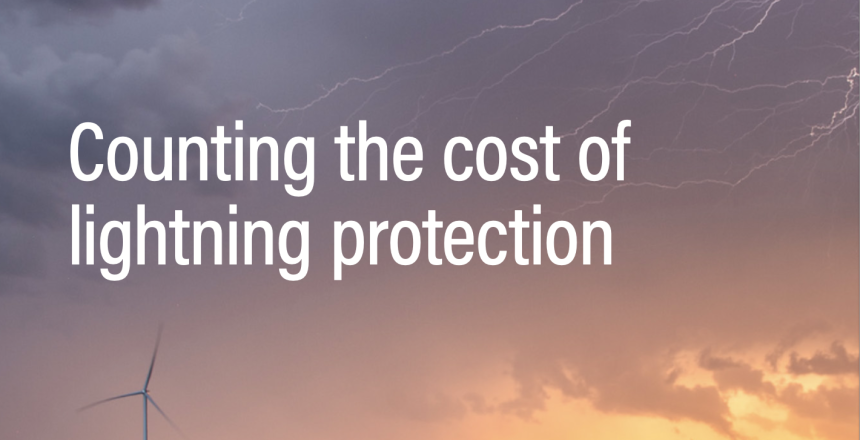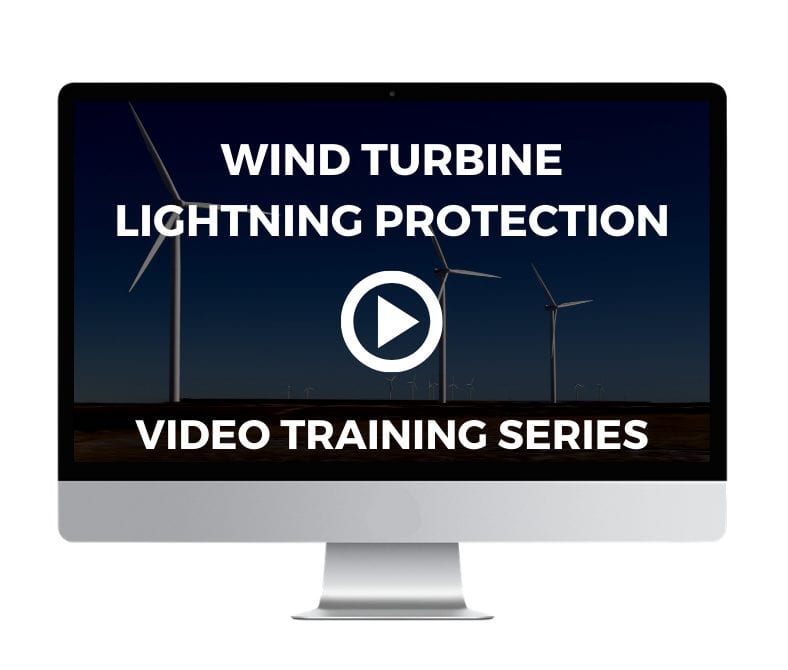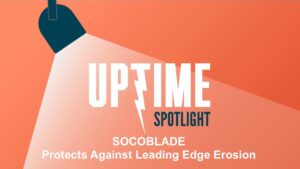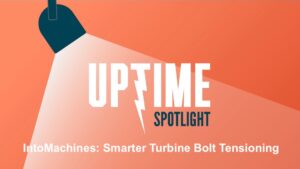This article on wind turbine lightning protection by Allen Hall, President, Weather Guard Lightning Tech, was originally published in PES Wind, Issue 2, 2023.]
Lightning strikes are powerful and awe-inspiring displays of nature’s fury. However, they can also wreak havoc on man-made structures, including wind turbines. According to industry experts, around 1 to 3 percent of lightning strikes to wind turbine blades result in blade damage. However, this figure can vary significantly, depending on the location of the wind farm, lightning strike characteristics, the type of turbine, and other factors. Let’s look at a few of the variables that contribute to the higher blade damage rates and how to address the unwelcome challenge.
When we think about a generic lightning strike to a turbine, the simplest model becomes our baseline. A conveniently located cloud sits a few kilometers directly above our pending victim wind turbine. The charge in the cloud creates a lightning channel that wanders down towards Earth and eventually runs into one of the blades that happens to be in the 12 o’clock position. In this thought experiment, the blade’s lightning protection system receives the incoming lightning energy and directs it safely to the ground.
In reality, the geometry between a thunderstorm and a wind turbine can be wildly different than in our theoretical model.
The wind industry searches for the best wind resources whether they are offshore, near-shore, or onshore at a few thousand meters above sea-level. These locations can be much closer to lightning-prone clouds or naturally active convective storm areas, putting the turbines at greater risk.
Upward strikes further complicate the turbine-to-cloud relationship. Strikes that originate from the wind turbine usually reach a cloud that is ill-prepared to surrender its charge. Why would this matter? Well, the lightning current from an upward strike can start and stop multiple times. Each time the lightning current stops for more than about 1/1000th of a second, a new lightning path to the blade is created, which gives lightning a second, third, or fourth opportunity to damage the blade.
The arrangement of turbines in a wind farm and the prevailing storm direction can greatly increase the likelihood of damage for individual turbines. While not a hard and fast rule, most storms globally travel west to east, and therefore turbines on the western edge of a farm will tend to take more strikes. On large farms, the turbines on the periphery will suffer the most lightning strikes. It is prudent to set aside a slightly larger repair budget for these turbines.
The desires of lightning are fairly basic. If a strike does not connect properly to the lightning protection system, due to the wrong lightning attachment, it will puncture the blade to reach the down conductor, carbon spar cap, or both. That means the damage hidden inside the blade can be considerably larger than a small hole on the exterior shell.
A common question from operators in lightning prone regions is ‘If a turbine takes a lightning strike, should it be shut down until technicians can inspect it?’ Most lightning strikes do minimal to no damage, so shutting down turbines after every strike would result in unnecessary power production loss.
A better approach is to use one of the several blade Continuous Monitoring System (CMS) products on the market, to detect lightning strikes and any subsequent blade damage. Australian-based Ping’s combined lightning detection and blade damage CMS system is an inexpensive option for lightning prone turbines. Another option would be the LASSIE system from Copenhagen-based Wind Power LAB. The LASSIE system utilizes data from a global network of lightning sensors, and it combines blade expertise with lightning risk control mechanisms to notify operators of strikes at the turbine level.
What should happen once blade damage is discovered? There are conflicting approaches across the industry. Some operators with older turbines just let the turbine run until there is a safety issue. On newer turbines still under warranty, insurance claims and inspections are the norm. Either way, a proper investigation and strategy should be executed.
What about the majority of turbines that are out of warranty, but need to operate another 10 to 15 years? The response depends on the category of damage, with Level 4 and 5 damage usually being repaired. What about Levels 1 to 3 damage? That’s where operators differ in approach with varying results.
Large operators and blade engineers who have a historic damage database and knowledge with a particular blade style can leverage their experience to decide on next steps. It’s the operators with a limited amount of data on a blade style that can struggle. Repairing a blade shell is relatively simple, but evaluating a damaged spar cap, or shear-web bond line, is a larger problem that generally requires outside experts. A repair made in due time may cost as little as €10k, whereas if the damage is left to propagate, €50-100k can come quickly. Worse, a catastrophic blade failure that could’ve been avoided.
The independent blade consultants at Wind Power LAB have created a simple series of steps to evaluate and put damaged blades back into service. The first step is to photograph the external surfaces of the blade with high resolution cameras. Drone companies such as Thread, Nearthlab, Clobotics, ZeitView, and SkySpecs are common drone inspection choices that produce quality images which are available on cloud-based platforms.
The second step is internal blade inspections. Most structural lightning damage occurs on the inside of a blade, where bond lines and composite shear web or box beam structures carry the massive blade loads. Internal inspections are critical to preventing catastrophic failures due to internal damage from lightning.
As Morten Handberg, Chief Blade Specialist at Wind Power LAB, points out, the internal inspections can be complicated, as damaged internal structure is not always near the puncture location. Once lightning punctures a blade shell, the lightning will travel several meters along traces of dirt, moisture, or oil in its search for a down conductor or carbon structure. That makes internal damage areas even more difficult to predict because lightning paths are random.
Internal blade inspection instruments and methodologies are readily available today from companies such as Wind Power LAB, Aerones, Arthwind, and Clobotics. They produce high quality images/videos with accurate location information that can quickly deduce structural issues. The robots and drones are designed to travel far up the blade in narrow spaces that technicians are unable to reach. No confined space entry, increased data coverage, operational efficiency, and lower technician needs are all advantages of the new approach for internal blade inspections. The key is to get clear video or images of the spar caps, spar webs, bond lines, and down conductor.
Third, measure the resistance of the lightning protection system (LPS). This simple check will identify issues such as a broken or degraded down conductor that may have caused internal structural damage to the blade. Lightning currents flowing through a broken down conductor can generate over 10,000°C of heat, which breaks down epoxy and can render the area structurally compromised.
Blades with carbon fiber spar caps or other structural members introduce an additional level of complexity to the investigations. Carbon fiber is sufficiently conductive to carry large amounts of lightning energy. Some blade manufacturers integrate the carbon structure as part of the LPS system, while others keep the carbon structure intentionally isolated from the LPS. Each design approach has advantages, but both are susceptible to lightning damage under certain conditions.
Recent industry focus has been on the isolated carbon fiber spar cap design because lightning can create high voltages that force flashovers between a spar cap and the down conductor. These flashovers tend to occur near the hub and towards the blade tip.
Lightning flashover events are not common, but Joel Saxum, Wind Power LAB’s Vice President of North American Sales, recommends analysis and guidance from experienced blade engineers. On-site inspections provide back-office engineers with better insights to understand complex issues such as previous damage and repairs.
Having a blade-specific engineer investigate damages is particularly useful for blades that have experienced multiple strikes. When this is the case, there may be more complex matters at hand, involving LPS system issues, possible retrofits needed, and/or refurbishment campaigns that can all strive to resolve lightning issues.
As global warming increases the frequency of lightning strikes around the world, detecting, inspecting, and repairing damage early will be key to extending blade lifetimes and a cleaner future. With drone and visual inspection data, blade engineers can make better informed decisions about lightning damage that ultimately reduce the cost impacts on operations.
# #
For reprints of this article, or to discuss better blade protection, contact us.
Image credit: Tom A. Warner, ztresearch.blog






